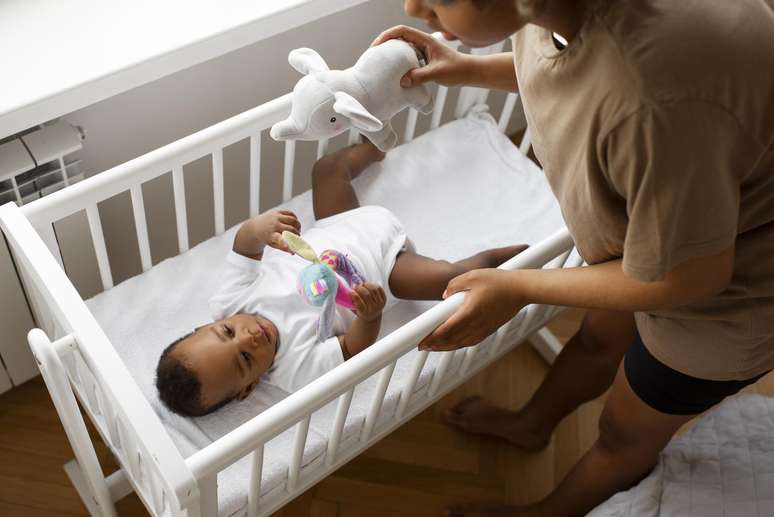The study shows that 87% of children go through this process by age three.
During the growth phase of the child, changes occur that require adaptation. One of these is the transition from the crib to the bed, which can create doubts for parents about the right time to do it. A study Published on ScienceDirect highlights that 87% of children go through this process by age three.
Some signs can help identify the best time to carry out the process. According to the American Academy of PediatricsThe first sign of change is the size of the crib. When it becomes too small for the child and the railing is less than three-quarters of its height, it is possible that the child will stand up by himself and run the risk of falling.
The guidance is for parents to switch to a toddler bed or a Montessori-style bed, which is lower to the floor. Recommendations include not using pillows until age two and avoiding bunk beds until age six.
You should also keep beds away from windows and electrical cords. Other options include investing in higher railings and purchasing a video monitor to provide additional protection for children during the transition.
What to consider to ease the transition?
For some babies, moving out of the crib can be difficult. After all, there is comfort in the old sleeping environment and increased intimacy, the result of a habit from birth. For parents, the baby’s resistance can make the transition difficult, but adjustments can make the new sleep space enjoyable, making it easier to adjust, experts say.
Use the negotiation technique
When you talk to your child about the new change, he or she is likely to be surprised and initially reluctant to accept it. One way to achieve this is to work with possible negotiations and involve the child in the choices. Providing children with options can improve their self-esteem and make them more likely to be excited about the transition, the ScienceDirect study notes.
The choices can concern the bed or the entire furniture of the room. The suggestion is to let the child choose the color of the paint or choose to use wallpaper in wood, with prints or neutral, depending on individual preferences.
Furniture can help make the space more engaging, such as patterned rugs and toys. Making your child feel like they have some control can make the process easier and get them excited about new things, the study notes.
Make a gradual transition
In an interview with the press, pediatricians Moises Chencinski and Maria José Carvalho Sant’Anna recommend that the transition from the crib to the bed be done gradually. Sudden changes can frighten the child and generate trauma, since he is distanced from something that generates comfort.
To do this, one suggestion is to place the new bed together with the crib, in the same room, and wait for the child to see the new bed as an option. Another alternative is to make the change in stages, placing the crib mattress on the floor and, over time, replacing it with one from the cot. This will make it easier for the child to adapt to environments without bars and closer to the floor, structures other than cots.
Sleep hygiene must be maintained
Another recommendation is for the child to maintain the same sleep routine during the transition. The ScienceDirect study concludes that a fixed schedule helps children fall asleep faster and wake up less during the night.
The suggestion is to avoid restless games during sleep and to perform actions that indicate that it is time to sleep. This can be done with a shower and pajamas, calmly and without agitation. When the change begins to take place, the child will feel sleepy and will accept the new sleeping environment, which will make the adaptation easier.
Patience is a prerequisite for successful change
The transition process from crib to bed can be exhausting for parents and baby. The recommendation is to have patience to deal with any stress during the transition. The ScienceDirect study reveals that parental attention is one of the main motivators of behavior, especially in children.
When the child shows stubborn actions or refuses to stay in bed, it is advisable to avoid negative reactions. Instead of fighting, you must be patient and repeat the process to avoid exaggerated behaviors and facilitate the transition.
Another guideline is for parents to celebrate each step. On the first night in the new bed, rewarding your child with a walk or a toy can make him work harder to adjust, making the process easier.
Tricks that can help parents
Some strategies can help parents in this transition process. Child and adolescent clinical psychologist Carla Valverde explains to the press that encouraging a bedtime routine helps the child understand what will happen before the separation occurs when he goes to bed.
Routines can include activities such as putting on pajamas, brushing teeth, telling a story or singing the same lullaby, as well as offering affection, kisses and cuddles. In this way, the child learns to recognize when to spend time with adults and when to go to bed.
The psychologist also recommends the use of calming objects, such as a teddy bear, a photo of the parents, a dream catcher or a very light blanket. In addition, leaving the light on initially can help children face their fears if left alone in their room. These supports can be gradually removed after adaptation.
Source: Terra
Ben Stock is a lifestyle journalist and author at Gossipify. He writes about topics such as health, wellness, travel, food and home decor. He provides practical advice and inspiration to improve well-being, keeps readers up to date with latest lifestyle news and trends, known for his engaging writing style, in-depth analysis and unique perspectives.








